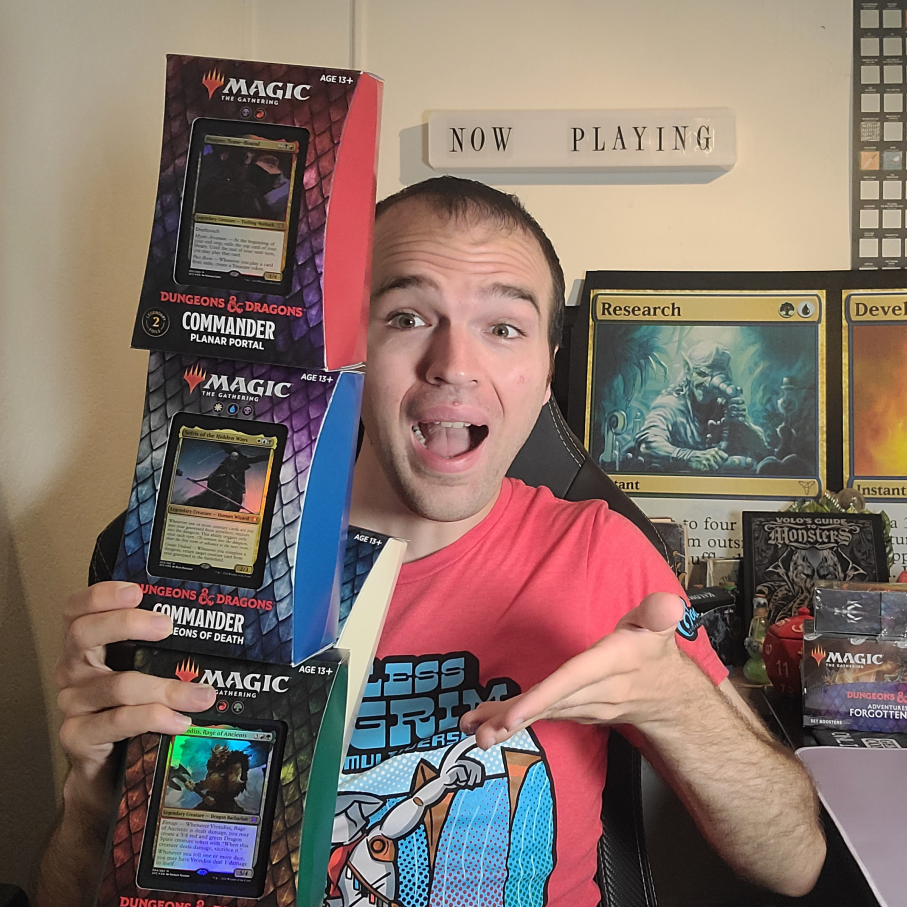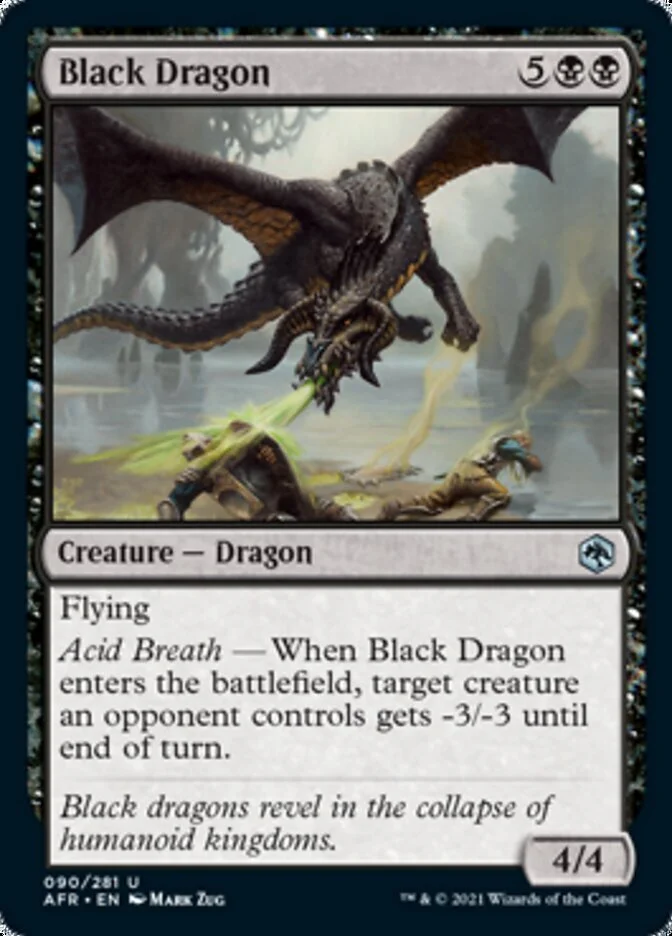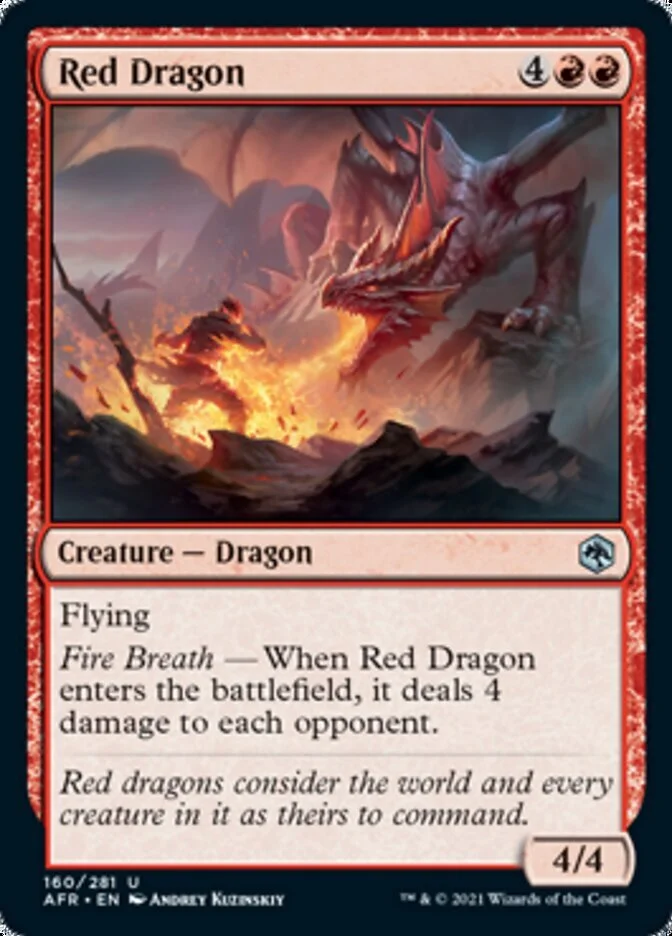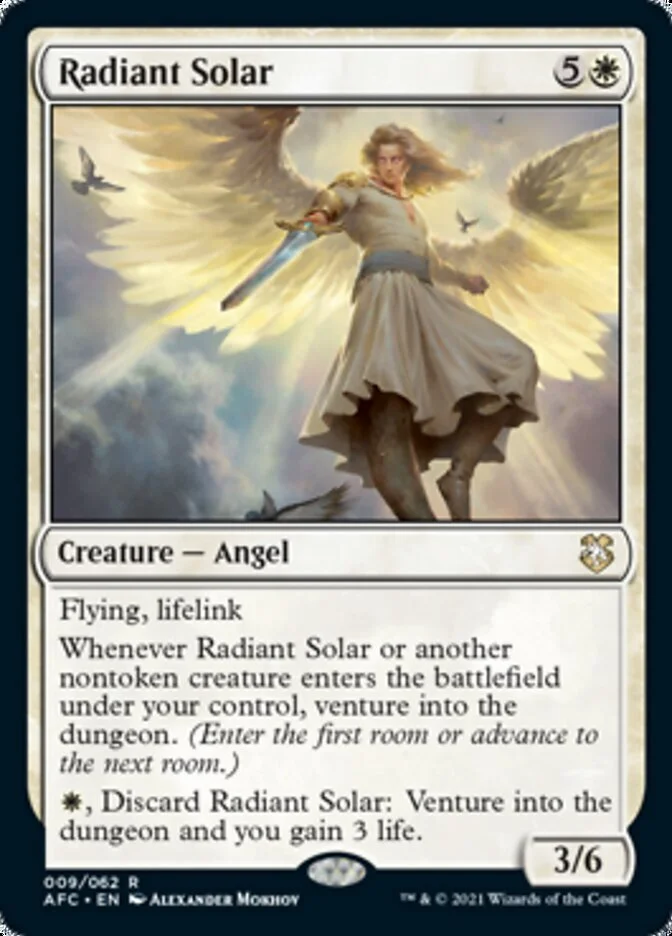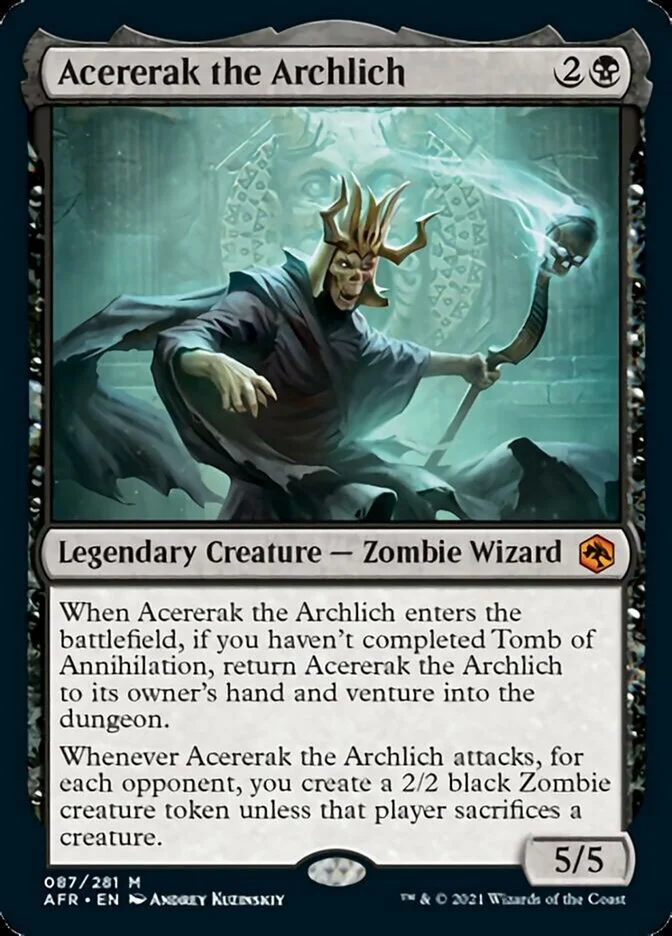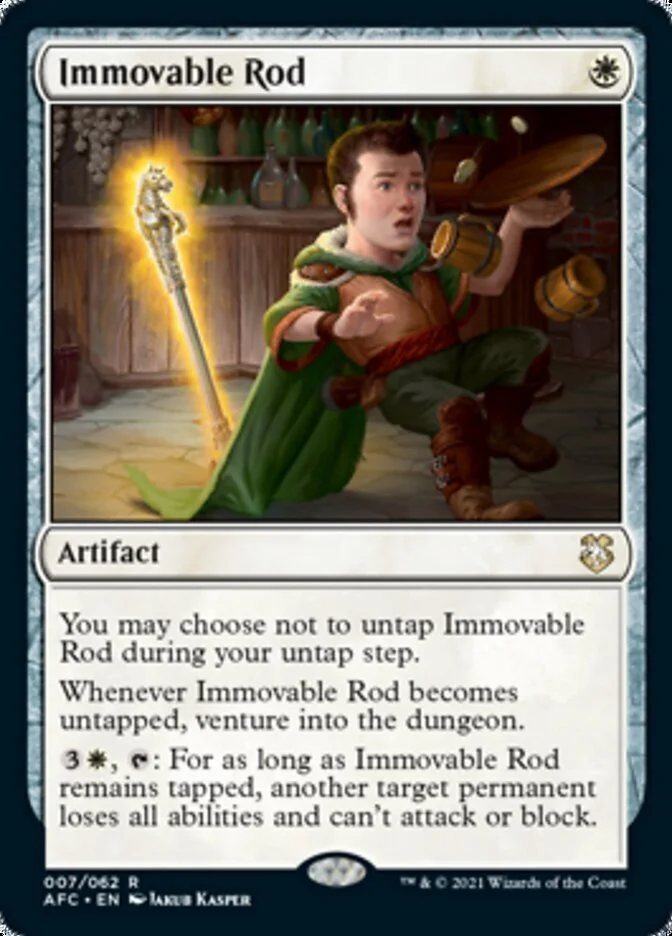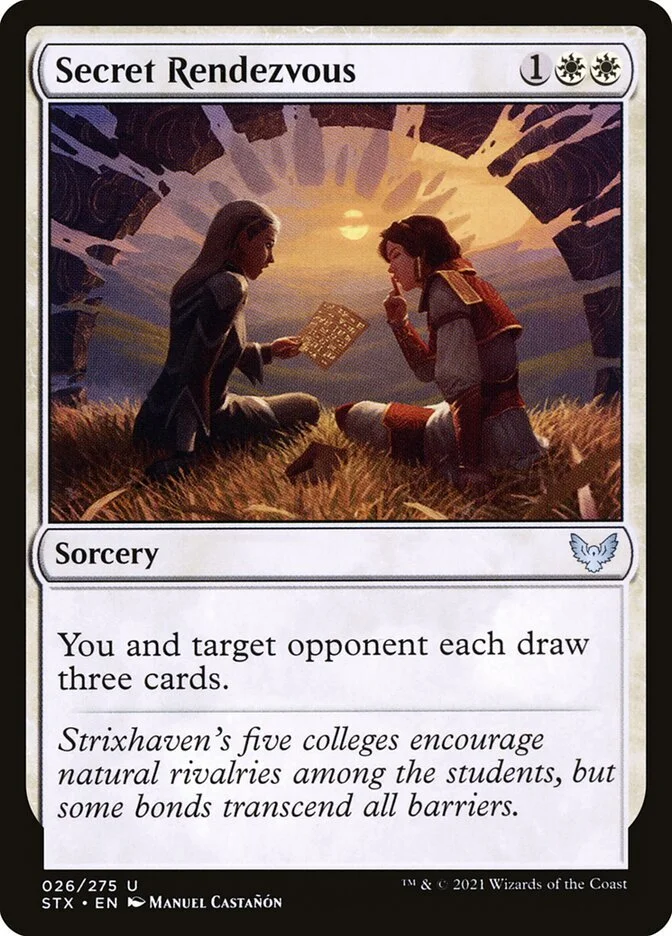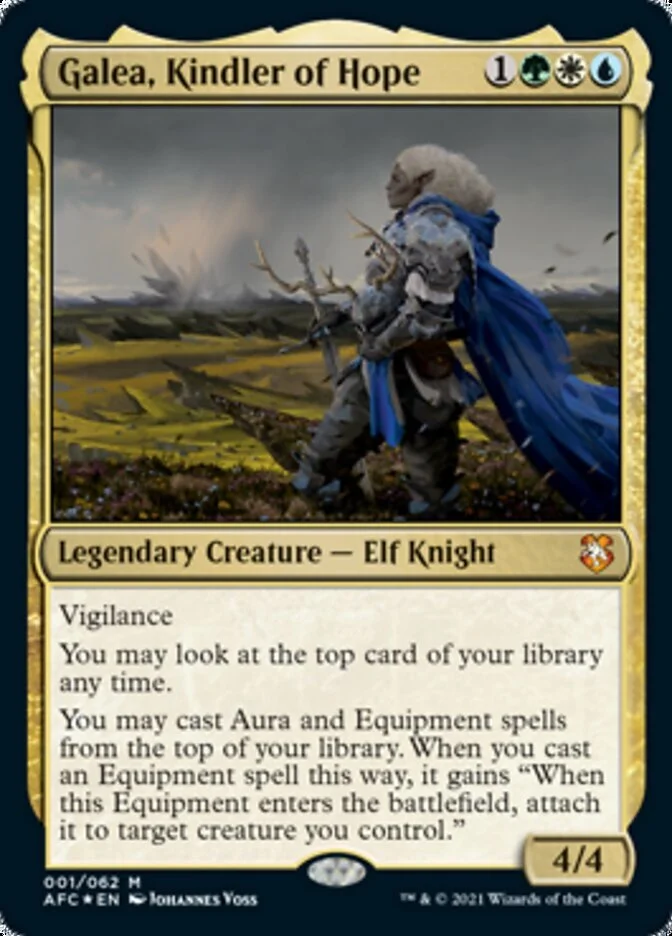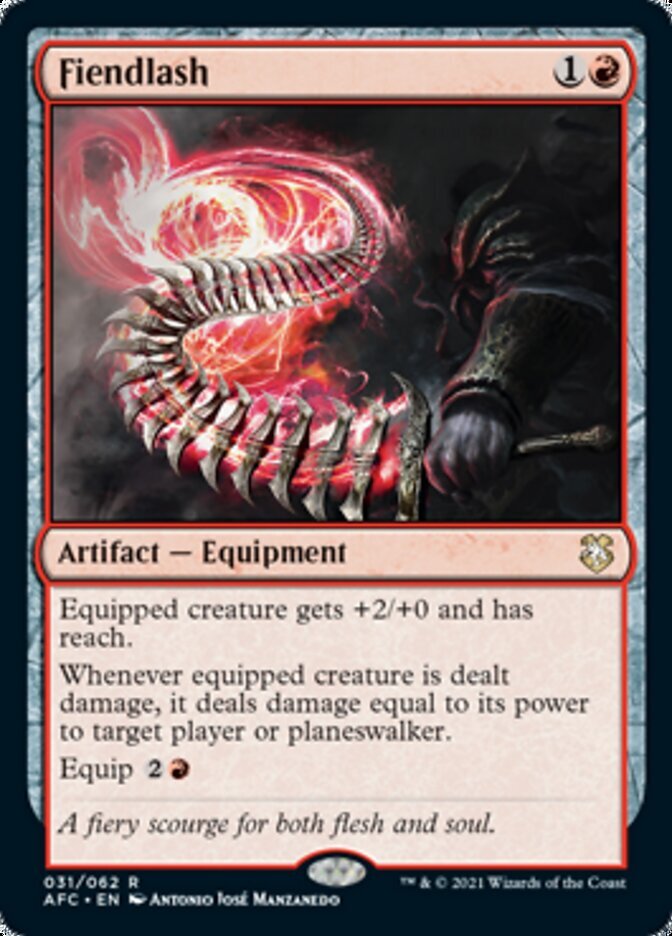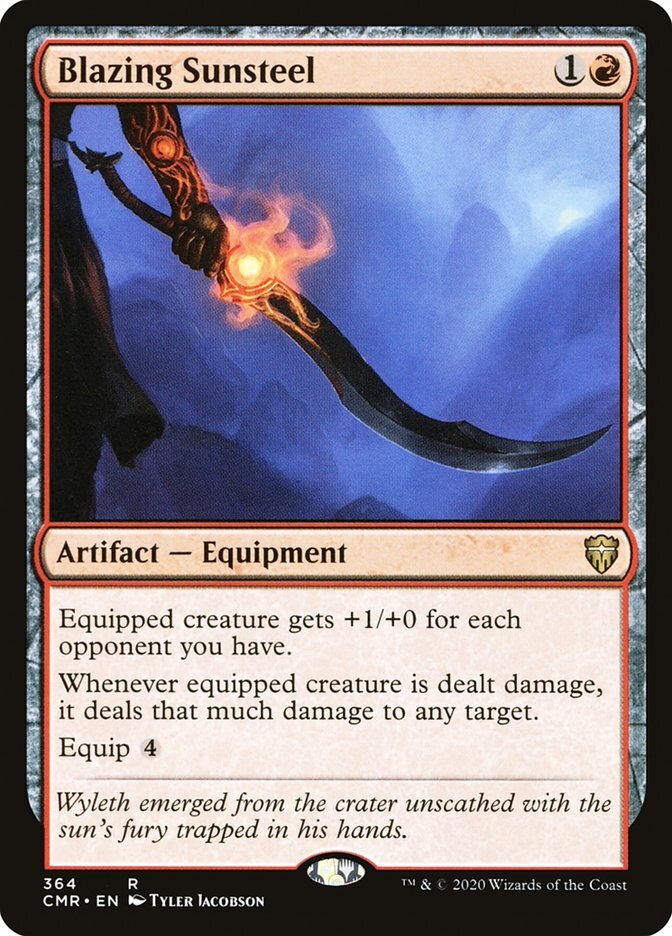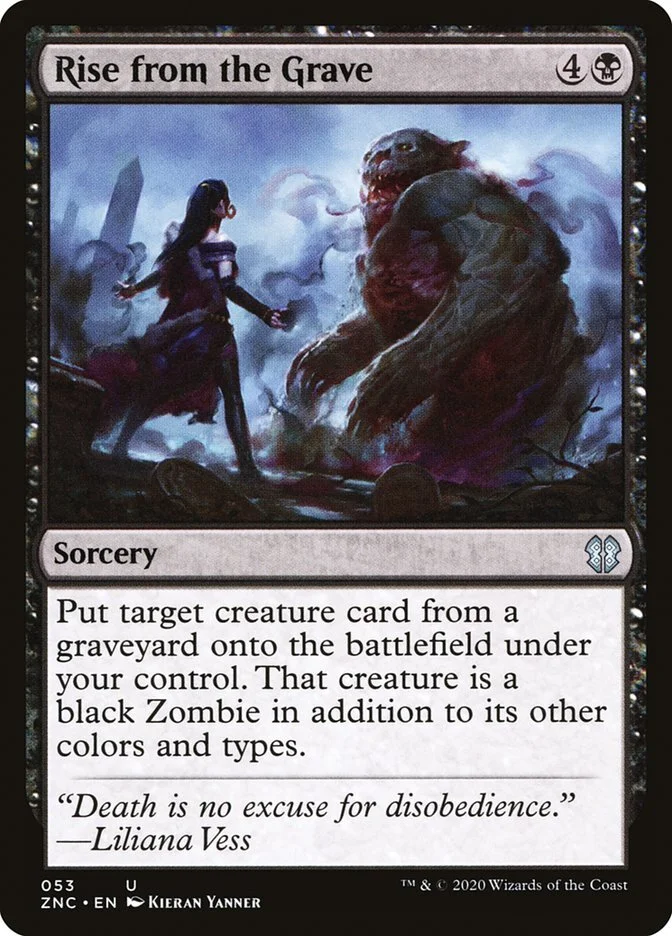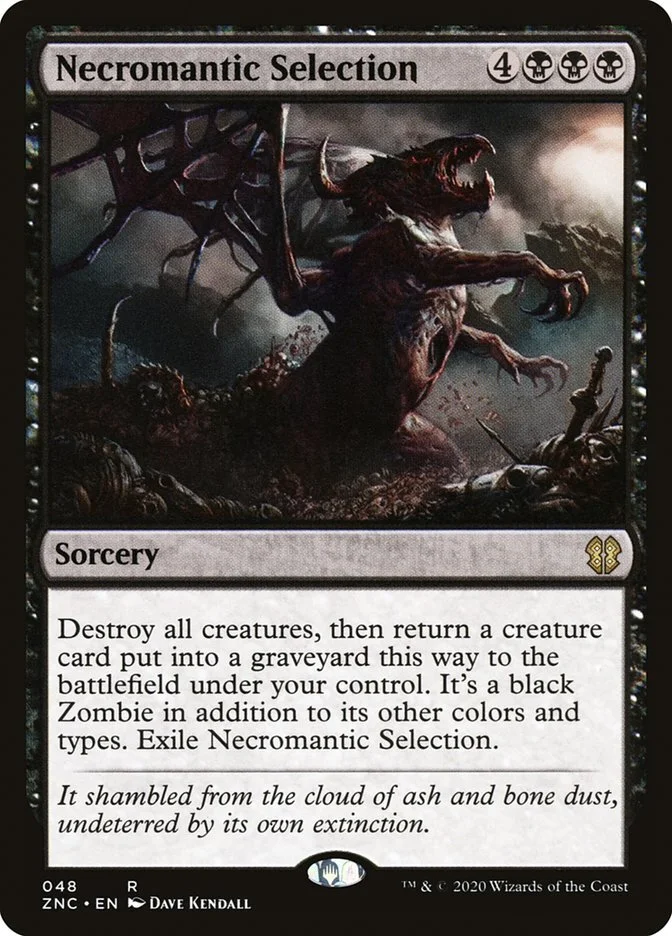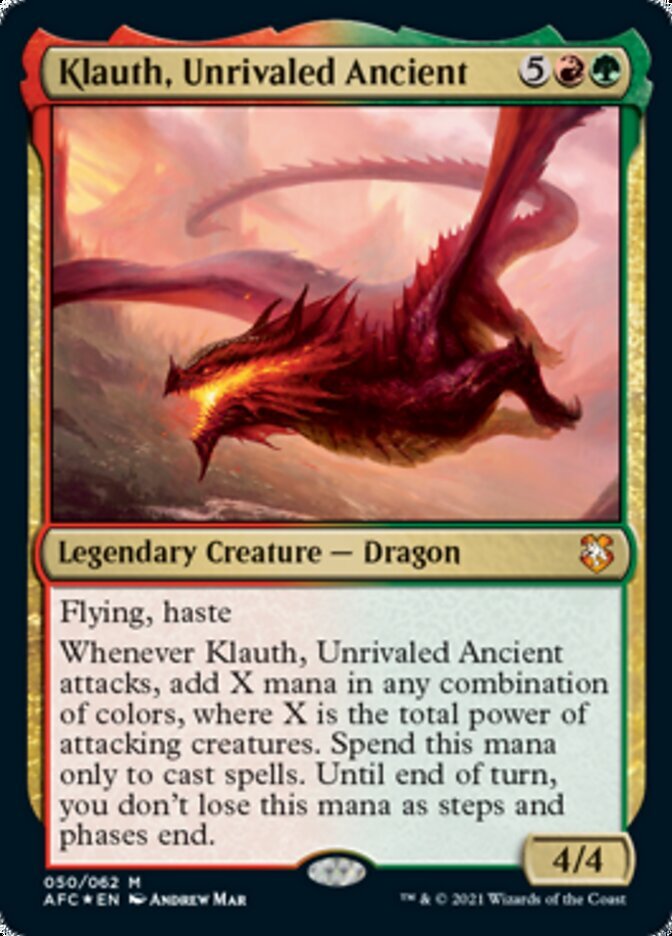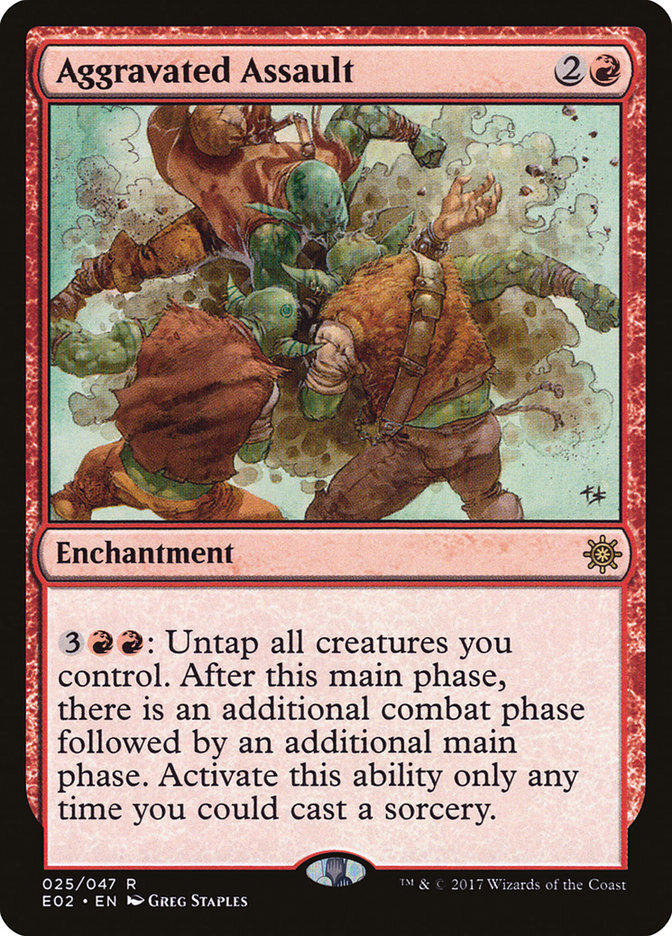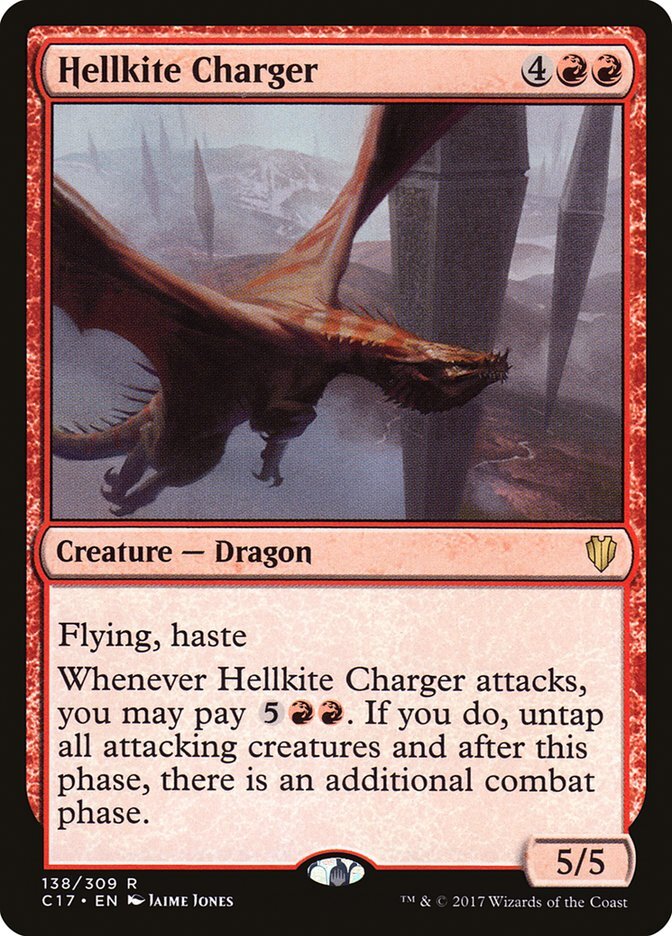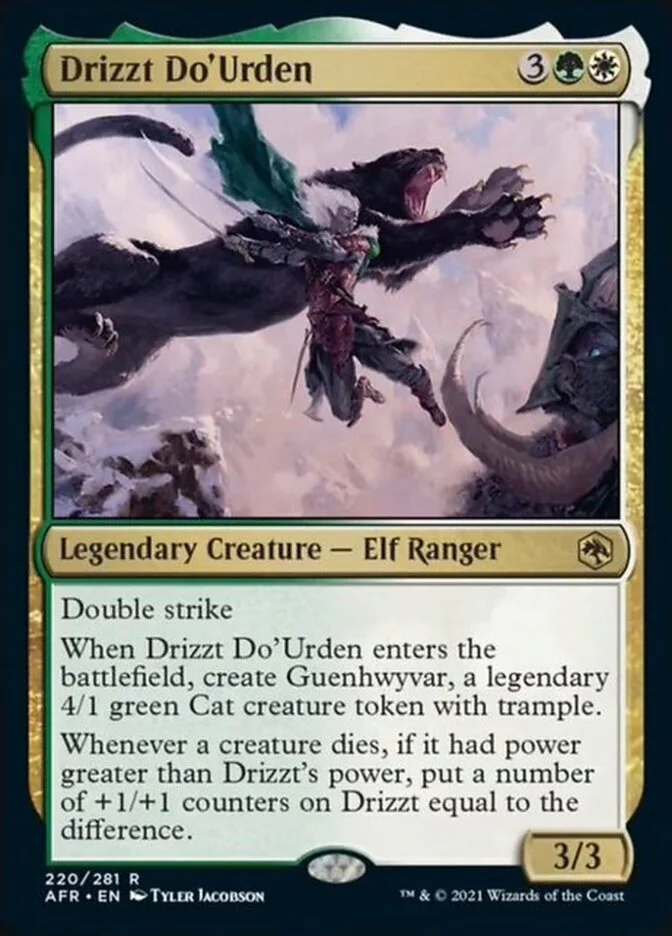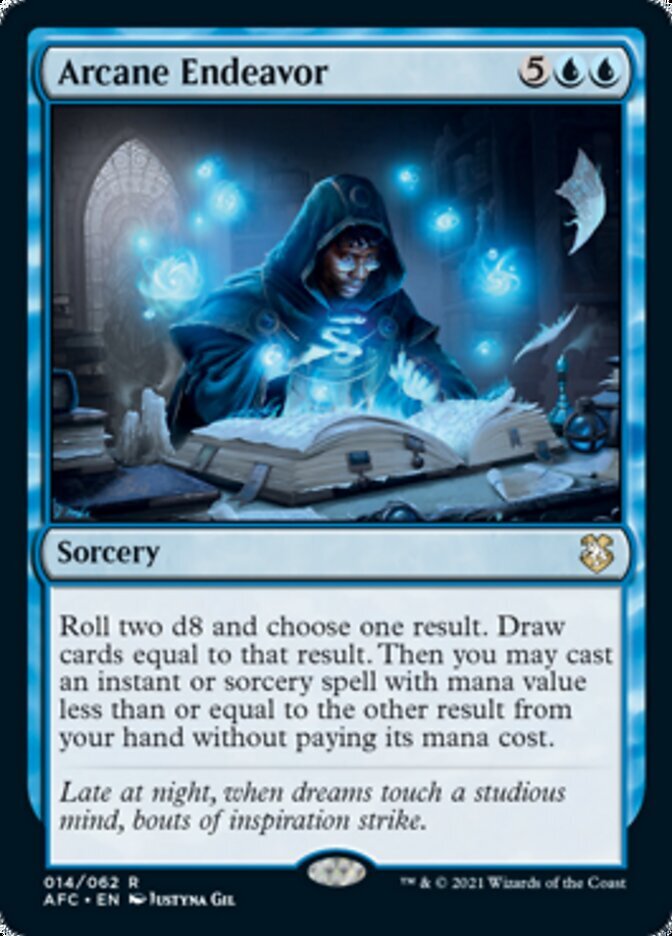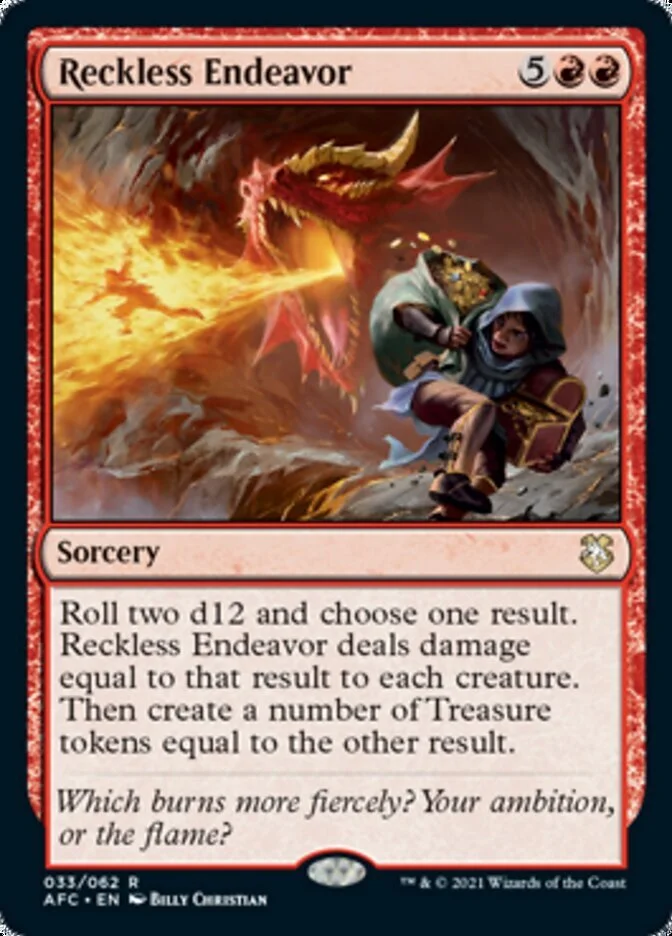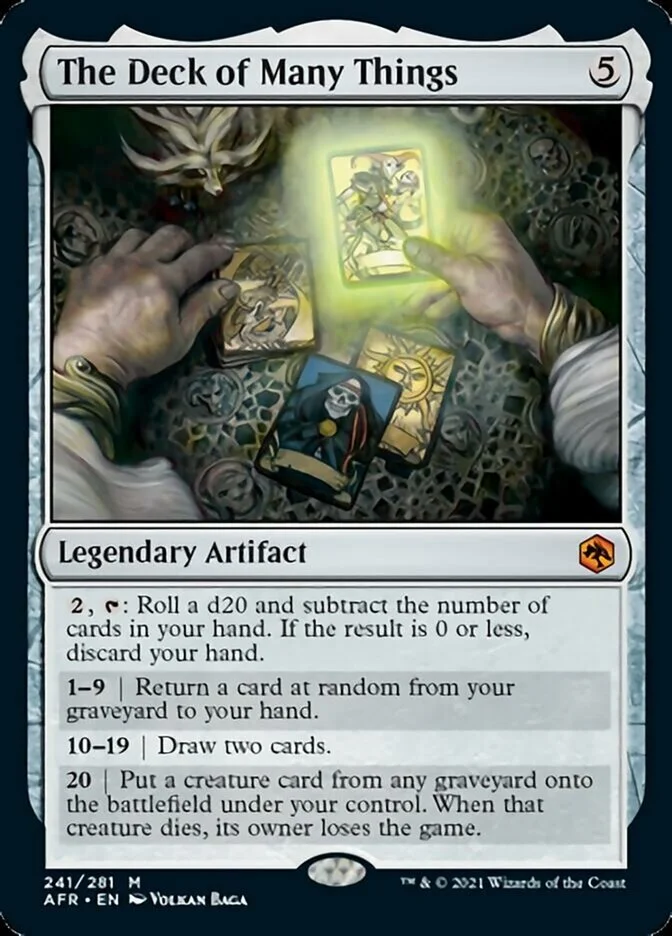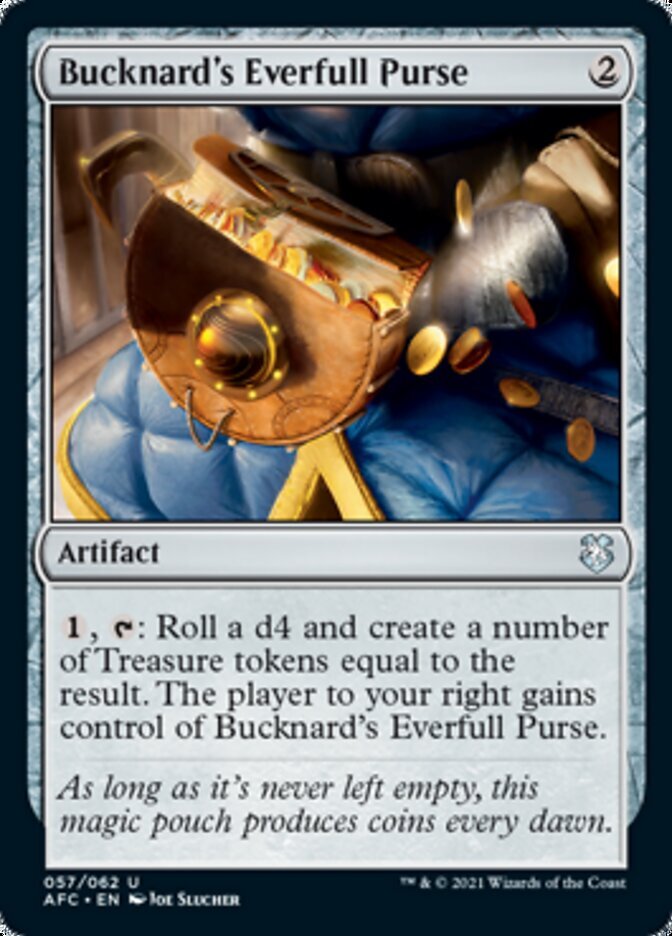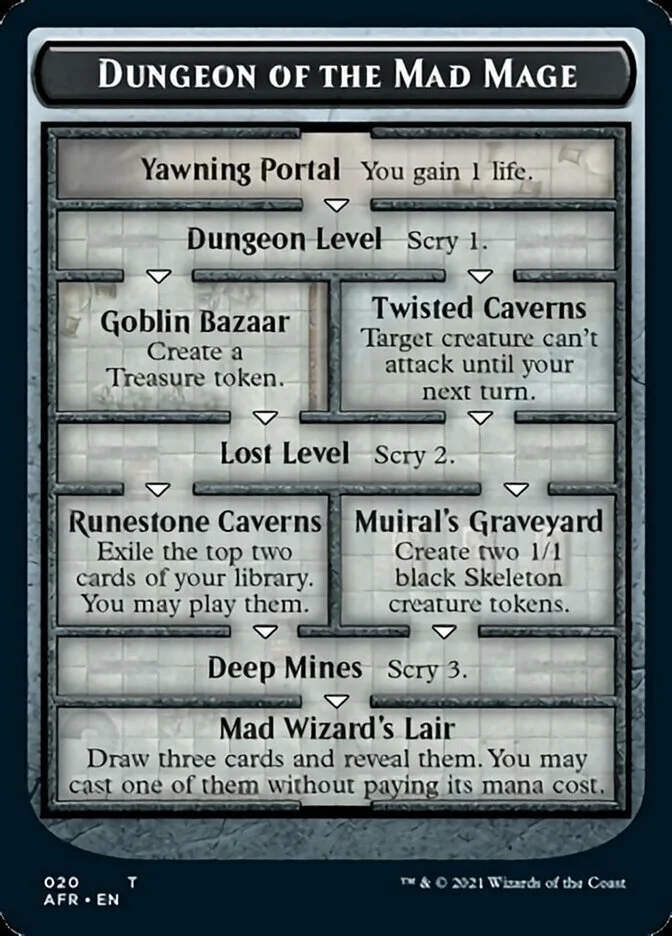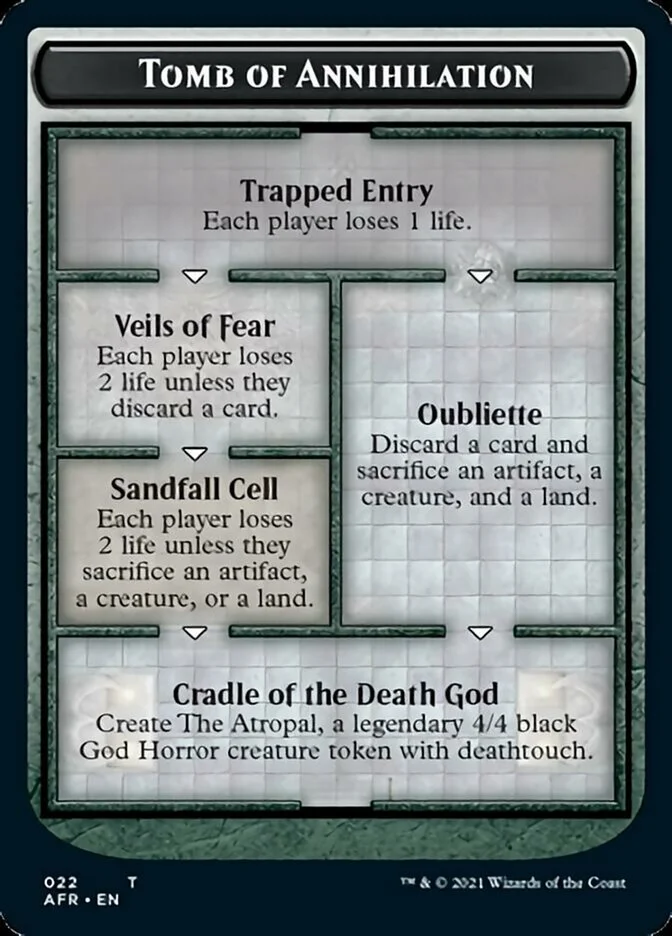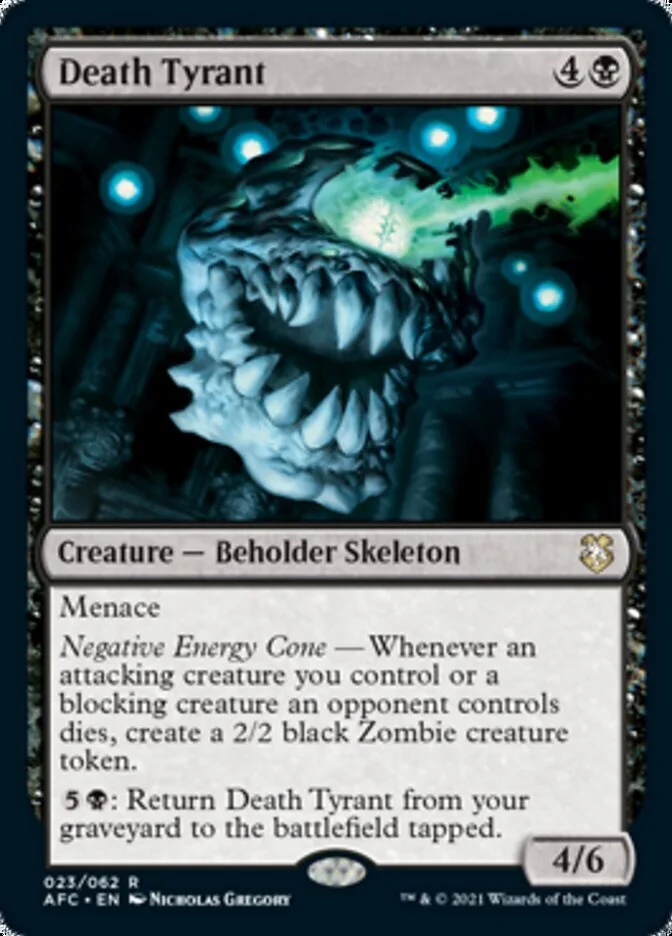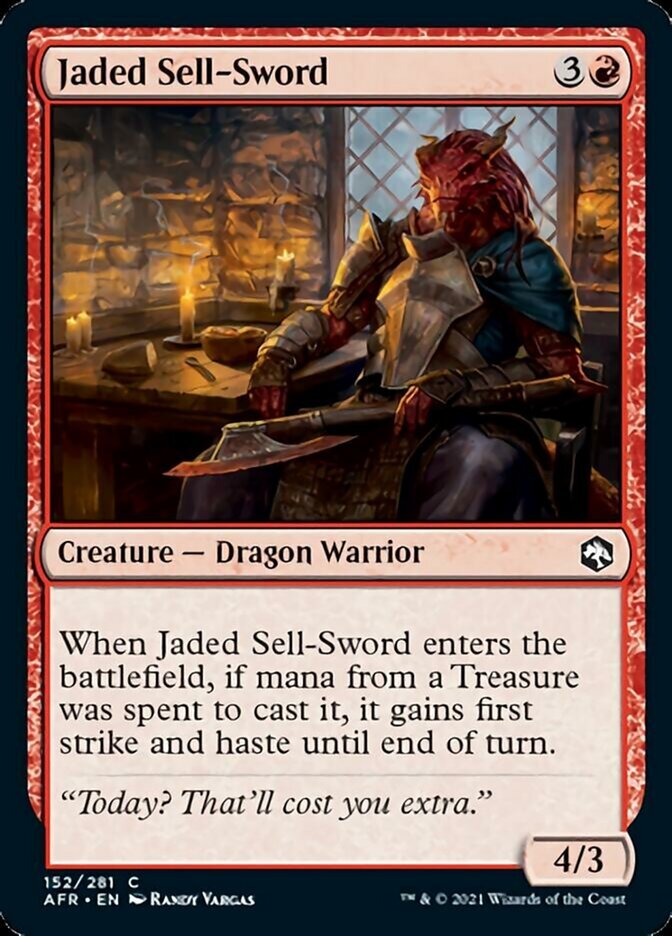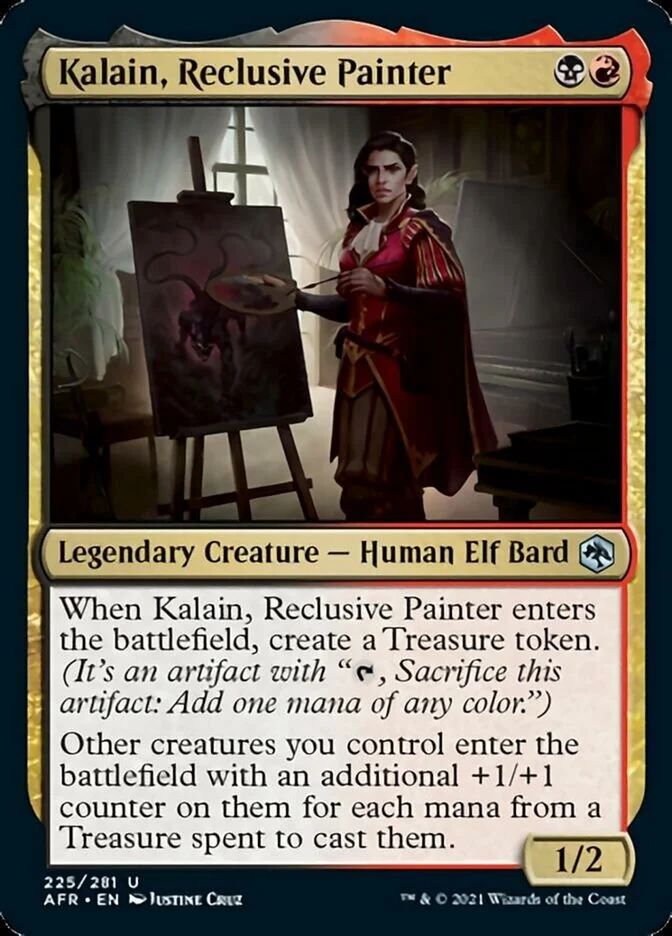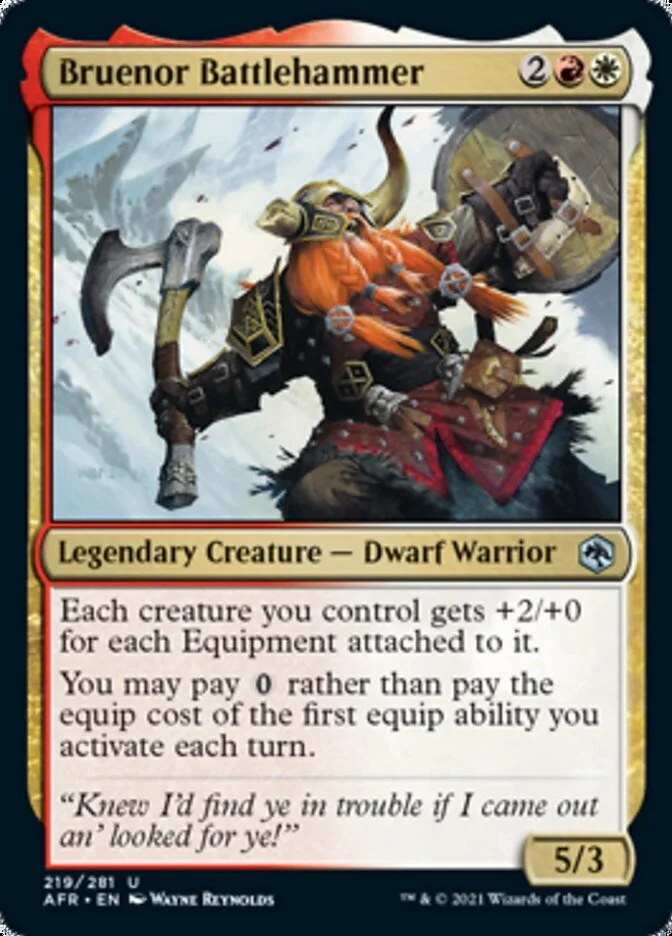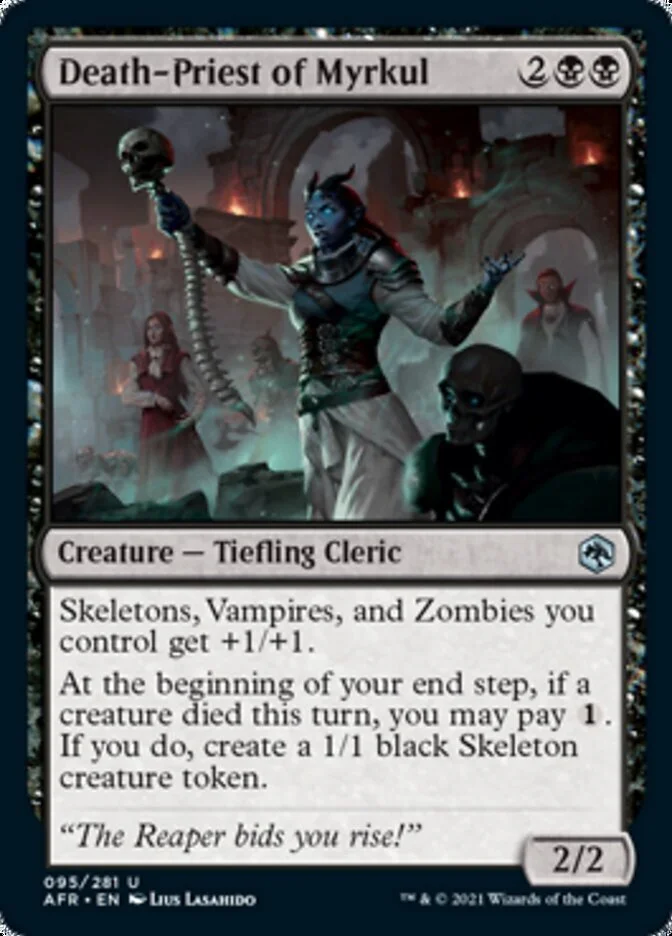AMA - Adventures in the Forgotten Realms with Gavin Verhey
Gavin Verhey and Chris Peeler joined PlayEDH for an AMA about the Adventures of the Forgotten Realms Commander decks, following the first ever standard set in the Dungeons & Dragons universe.
On PlayEDH’s side of things, Senatorious was the one relaying the questions people asked, and the AMA was held on our Discord (https://discord.com/invite/playedh) server using the stage feature.
People were able to send in questions ahead of time, and had an opportunity to ask more questions after the pre-selected questions were answered.
Enjoy the read! We hope you find some interesting tidbits and info about this new set.
We’ve further tried to improve the way our website displays cards and images in articles.
All cards should be click/tap to zoom from now on. ~Exxaxl
Senatorious asks:
What cards were you most involved with designing for the new precons and which deck did you have the most influence over in the design process?
Gavin: My role on these precons was architect, so I was not the lead designer - that was Glenn Jones (https://twitter.com/glenn_jones_), who did a great job on them. As the architect my role was to work with Glenn to help answer questions, guide him, give feedback and work on all other aspects in the set, working together with other departments as well.
One story that I like is about the card Immovable Rod. Up until the very end, right before we were going to ship these cards more or less, this was a blue card, not white.
This card got designed right around the time where the community was vocal about ‘Hey, why are other colors getting things that white should be getting?’ - so I told the team to do a pass on the upcoming Commander sets and see if there’s anything that could be white, that isn’t in white currently, that we could move to white. The question should be ‘why can’t this effect be white’.
This was a great example of a card where it was originally blue, and it’s a thing blue could do, but looking at the card, it’s a lot more white, so we moved the color, and I’m happy we could make that impact on the set. One of many small ‘shift to white’ fixes to give it some extra tools in EDH because we all know white is the color that needed more help in Commander, and it’s starting to get some pretty cool stuff.
There are some great cards in this set for white, both in the regular AFR (Adventures of the Forgotten Realms) set and the Commander decks. We’ve had some in the previous sets, and there’s some other fun stuff coming up too so stay tuned.
Senatorious: It’s really interesting to hear about behind the scenes design decisions like that and I think the instinct to take a look at cards and see if their design could be done in white is great.
Gavin: One thing that changed is the blue version tapped it and locked it down, and the white version says it can’t attack or block. We changed some words around to fit more with white, and it’s an appropriate white card now.
Beard Umbra asks:
How has Dungeons and Dragons influenced you as a Magic designer?
Gavin: So so so much. I started playing Magic before I played D&D, when I was about 10 years old. When I got into Magic, it wasn’t much later that I also got into D&D, because you’re in the card shop, and you see the table where people are playing D&D and you get curious, so I asked if I could join their game - I was maybe 12-13 years old at the time and they’re all teenagers and early adults - but they said “Yeah, join our game!” and this was really important to me.
It entered me into the whole world of gaming tropes and adventuring tropes and things that would become very important when becoming a Magic designer, and taught me flexibility as well. D&D is a lot about improvisation, as you’re coming along, deciding on what you want to do so it breeds creativity as well, in addition to giving me a lot of flavor to work with. D&D also showed me the power of community.
In Magic, especially back then before we had Commander - it was a lot about sitting down and smashing your opponent, it was mainly one on one Magic - and D&D is so different, it’s a cumulative experience. I think the early D&D adventures really got me hooked into the idea of the community, and working with everybody else, which in turn wanted me to get invested in the Magic community even more and try to build that. And now I’m so deep into the Magic community which in part is because of those D&D experiences.
When we designed these precons, although it is a free for all, there’s still a fair amount of wheeling and dealing, and most of all making sure everyone is having fun, which is something D&D more often brings to the table.
I’m glad I had those prior experiences, because it’s influenced how much I care about building these communal experiences for people now.
Senatorious: So you were able to bring the community focused vision and other D&D aspects towards designing cards for Commander. You said you were more of an advisor on this one, but that eye towards the positive interactions in Commander, there’s a lot of space for that.
PraiseTheSunday asks:
When developing AFR did you cooperate with the D&D team of WOTC in any way?
If so, how was this process - if not, was this something you considered?
Gavin: Yes, we absolutely worked with the D&D team. It’d be pretty wild if we released a D&D Magic set and went ‘Nah, the entire D&D team, we’re not interested in your help, thanks’. It’s really interesting that we make Magic and D&D in the same building - well, not right now with Covid19, but technically - but we seldom work on the same project. D&D does its thing and Magic does its thing and never the two shall meet.
About 5 or 6 years ago James Wyatt (https://twitter.com/aquelajames) came over from the D&D team to work in Magic’s creative team, and with him he brought a love for D&D. He started working on D&D Adventures he would put up on our website that people could play through, and that started bridging the gaps between the two teams. Eventually we started coming out with things like Guildmasters' Guide to Ravnica and that paved the path of making this interaction, a D&D Magic set.
Everyone was excited about this from the top down, people like Chris Cocks (President and CEO of WOTC) were excited for this to happen - he wanted it to happen. We built that all the way up, so that was cool.
So we started working on this project, we brought people over from the D&D team, and we had D&D designers working with Magic designers - it was really a group effort.
It was cool being able to walk over someone from the D&D team like Chris Perkins (https://twitter.com/ChrisPerkinsDnD) and say “Hey, we’re making a Beholder, can you give me a quick rundown of all things Beholders can do?” and then of course they’ll tell you this amazing 8 minute long story about the history of Beholders and everything they can do and you’re just transfixed to your chair.
Normally when we build a new Magic set, we build the entire world, we build a world guide, we spend a lot of energy building it up, and we have to create all that lore from scratch. Whenever there’s a question, we have to answer that ourselves. “What do the Kor do on Zendikar? Well, I guess we still have to make that up, so we don’t know yet.” This set is different in that we were able to walk across the hall and go “Hey, here is an established world full of lore that’s been around for decades, tell us a story” and then we’ll make cards around it, and that was super cool to me.
Senatorious: Your answer kind of delved into what the next question was so I’ll just kind of shorten it. You talked about how there were interesting aspects you were able to pull from D&D lore, but it ties in well with this follow up question.
PraiseTheSunday asks:
Were there any challenges that you experienced having to deal with a world where you couldn’t just make stuff up if you needed to?
Gavin: The great thing about D&D is the whole world is built on making stuff up, so of course we could make stuff up if we needed to, if we wanted to make a character or a card we would find something to make it work.
It’s kind of the inverse, which caused us the most consternation. In D&D there’s a lot of things we wanted to represent that have very non Magicy names. There’s the cycle of colored dragons, Green Dragon, White Dragon, Blue Dragon, etc.
In Magic we wouldn’t call a card ‘Red Dragon’ - that almost sounds like a playtest name, but here in a D&D set it’d be the name players wanted. As a result, we were going to do a couple of cards that we normally wouldn’t do like green flying creatures, because ‘dragons’ is in the name of the set, so we’re going to give every color some dragons. We’re going to do non-flying dragons to get some dragonborn, so that was something brand new.
The biggest things people kept bringing up when they were looking at the set were actually the things from D&D we were bringing into Magic. “Hey, why doesn’t this dragon fly?” - and especially when the cards don’t have art yet during development - ‘Well, because it’s a dragonborn, not an actual dragon’ - so there was a lot of designing to do there.
Among Magic designers, it was almost like a retraining. ‘Hey, I know what you’re used to designing Magic, but we’re doing D&D, which is similar but not identical, it’s going to have some different things you’re going to have to know about’. By the time art showed up, it was definitely a lot more clear what every card was doing.
Dukeblock asks (and Deimos asked a similar question):
Is there a particular reasoning why these 4 precons were given these color combinations? While it is nice to finally get a Gruul precon, this would be the third Esper precon across the history of Commander precons.
Gavin: When it comes to color combinations, we need to make sure we hit the themes we want to hit. Glenn Jones decided early one we should be doing things with dice rolling and dungeons.
In the main set, dungeons are white blue and black. Given that the only dungeon cards currently existing in all of Magic would be coming from this set, that precon made sense to be all three of those colors because then you could play all dungeon cards available to you - that’s where the Esper deck came from. And I know it’s our third Esper deck in recent years, it just made a lot of sense to do that here.
On the flip side, the red green deck - the die rolling deck - we wanted to have a precon that wanted you to roll dice, and lots of them. ‘We should have a face card that cares about dice, red green makes some sense.’ We just looked at themes that made sense in what the set was doing. ‘Oh, there’s a lot of equipment in D&D, that makes sense for Bant to do here’.
The way these processes often work is that the team will start, and everyone will start brainstorming ideas about what they think they want to do with the set, and what makes a lot of sense to hook into. Now that we’re doing these set-tied Commander decks, often we want some of them to tie into the main themes of the set. Let’s figure out what main themes we want to tie into and then given what else is here, what can we play around with that makes sense.
There was no ‘we finally have to give red green a precon’ or ‘we shouldn’t do another Esper precon’. We looked at what would be the most compelling for this world, and given how many Commander precons we’re making, you’re going to see overlaps happening just because of how many precons are coming out.
We’re trying to be conscious where possible - like making Galea care about auras and equipment, as opposed to just auras like the Estrid precon from a few years ago - we’re trying to find different twists to put on them, but you will see overlap in the future.
We’ll always try to make sure things are separated and interesting, and by tying into the set themes, we get a lot of room to work on precons that have never been made before. There was no mutate precon before Ikoria, because mutate didn’t exist. There was no dungeon deck before AFR, because dungeons didn’t exist.
Senatorious: Considering all of the dungeon related cards are in this one set, you’re looking to make precons for sets where you can upgrade them with cards from the new set?
Gavin: Yes, definitely. You’ll want to be able to get cards from the regular set that you can upgrade with, we want to be able to put cards in the precons that have these new mechanics as well. Think about all the times, and this happens to me constantly, players will ask “Hey, why can’t we get a Commander for x, because” - “Why can’t we get a red white samurai Commander, Godo is only mono red” - for example.
If we’re going to make a Commander for an archetype, let’s make it all of these colors, because that will allow players to put in cards in those colors they already have. If we made Sefris to only be black blue, you couldn’t play any of the white dungeon cards from the set, and who knows if we’ll ever do dungeons again. It’d be really sad if a brand new Commander that cares about dungeons, wouldn’t be able to play the white dungeon cards in EDH. We wanted to make sure we covered all the bases there.
LordToastado asks (and Onceisonce asked a similar question):
How did you decide on which characters would be creatures and which would be planeswalkers? We know this question leans a little more towards the main set, but this was a question that a lot of people were interested in.
Gavin: I wasn’t hyper involved with this part of the design process, but my understanding from talking with the creative team is that this was a joint effort by both teams (Magic and D&D).
They looked at figures that have a history of doing things with the planes of D&D or being able to do things at a super high magical, mystical level - like Mordenkainen is at that level, Bahamut is at that level - these characters hit that mark, of being able to traverse all kinds of realms, and really being able to open up things to gigantic power.
From a player’s perspective as well, I’ll say that it was mostly chosen by Creative. It makes sense to put some of our most iconic D&D characters in as planeswalkers - Mordenkainen has been on books, Lolth has been on books - so while we did add some new ones like Ellywick, a lot of them are super iconic characters that made a lot of sense as planeswalkers. I can’t say this with 100% confidence, but that was my understanding on how those things got decided, that’s my understanding of them.
A question I get asked a lot as well, I don’t know if people asked here or not, is “Why did we not get an Elminster card?”. There was a lot of chatter around this, and I asked Creative and Jules Robins (https://twitter.com/julesrobins) about it, and it kind of boiled down to doing Mordenkainen or Elminster, and Mordenkainen was just more well known. He’s been on the face of books recently, so we went with him for this set. If we ever do a D&D set again in the future, Elminster is right at the top of our list of cards we want to make. We didn’t forget about him, if anyone one there thinks that.
Chris: I’ve talked with some of the creative team folks, my understanding is at least partially the decision for planeswalkers in the set was whether or not the characters in D&D had the ability to travel between planes within the D&D cosmology.
It doesn’t necessarily mean they’re planeswalkers in Magic’s sense of the term, or can traverse the Multiverse like that, but making sure that those characters were technically “walking planes” within the fiction of D&D was part of what informed that decision.
Gavin: Great point. D&D Planes and Magic planes are different, right? They sound very similar but they’re a little different, but planes still exist in D&D.
Beard Umbra asks (and Locust, Voltron King asked a similar question):
How do you test Commander decks? In addition to decks in the same set, do you test against other decks in development, other decks already in print, your own homebrews, etc?
Gavin: This depends on the kind of Commander decks that we’re releasing. This is a great question because I don’t get asked this very often. For decks that are what we call a ‘biodome’ experience - decks that come in amounts of four or five, like the ones in AFR or Ikoria - we tend to test these decks mostly against each other, because we’re trying to create a biodome where all these decks will play together.
Towards the end of the design process, we take them out and we play against other decks. We’ll also take the Commanders of these decks and build our own decks around them, so that we can go “What’s the most awesome optimal version of Galea you can play” and things like that.
The vast majority of playtesting is with these four or five decks from the same set, because we notice people often play these decks almost like a board game, where they’ll buy all the decks and then play them out of the box against each other, that’s their play experience.
With the two deck sets, like what we saw in Kaldheim or Commander Legends or Zendikar Rising, what we tend to do there is play the two precons against the two neighbouring precons. We playtested the Commander Legends decks and the Zendikar Rising decks against each other, for example. It makes for a nice rotation, where we’re working on Commander Legends and Zendikar Rising, and we’re testing those four decks, and then Commander Legends development finishes, so we’re now working on Kaldheim, so we’re now testing the Kaldheim and Zendikar Rising decks together.
Again towards the end of the process, we’ll play them against other Commander decks or build our own decks ourselves. But a lot of the time people are purchasing these decks to play against each other, so the things we want to check for are ‘Do these decks work well in their biodome’ and ‘Do these cards work well out of context somewhere else, or are they going to be overpowered’ or ‘Are they going to call these frustrating, unfun decks’ or ‘Are there cards in your deck that are doing a totally noble wonderful thing, but when you take them outside of the context of this precon, start doing horrible, frustrating things’ - that can happen sometimes too. That’s why testing is really important.
Senatorious: To bring something just posted on our Discord chat, from Sigi: You should just bring them to us, we’d be happy to playtest them for you.
Gavin: We’ll keep that in mind :-)
Kraum asks:
The X's Will cycle (like Akroma’s Will from Commander Legends) was extended, but only in the Draconic Rage deck with a multi-colored version. Was there a reason for not adding more cards to the cycle in the other precons?
Gavin: Klauth’s Will was just an independent card, where Glenn was looking for a sweet card for that deck, that made a lot of sense and cost a lot of mana, a cool X spell, and this is the card he came up with. It’s not coincidental, because of course he knew about the Commander Legends cards, but it’s also not meant to be ‘part of anything’.
It’s not like we made a whole lot of ‘X’s Will’ cards and then deleted the other four - it’s just a one off card. But we did name it Klauth’s Will, so that if we did end up wanting to make a cycle in the future, we totally could.
I’m not going to give away right now if there are going to be more Will cards in the future or if there’s going to be a supercycle over time, but if you’re interested to see those cards in the future, do let me know on Discord or Twitter, that feedback is useful. If you like these cards and you want multicolored ones, we can make them. We have that power.
Senatorious: We have a question you’ve partially answered already, but there’s a little aspect in here that I think would be good to ask.
Chief, Mono-white specialist asks:
What was the design process behind Immovable Rod (which you already answered) and should we expect white to get similar cards moving forward? That design is rather interesting.
Senatorious: You did say you would be on the lookout for designs that could be white, but in terms of these artifact based, optionally reusable ‘leave it tapped’ kind of effects - Is that something that we might see more of in the future?
Gavin: Beyond Immovable Rod, we’re trying to give white a lot of things and testing them out, to see how they will get adopted into Commander. Part of the thing in testing ‘why this color’ is some things are going to work, and some things aren’t.
If you look at Strixhaven, we made some cards that hit pretty well like Archaeomancer’s Map, and we made some cards like Secret Rendezvous, which people weren’t as big a fan of. Some people liked it, and some folks were “why would I ever play this?”.
We need to test a lot of things out and see what sticks and see what works. We’ll be looking closely at the data on places online, what fans think about cards like Immovable Rod going forward, but it’s certainly a thing white can do, so we can definitely do similar things in the future.
Infectchils asks:
What was your favorite mechanic to develop for these precons?
Gavin: The precons have a lot of different mechanics. One of the fun things about Commander precons is we get to pull mechanics from anywhere and everywhere in the history of Magic, on the larger level getting things like dice rolling and dungeons, which span entire deck themes for these decks was really fun, because we never got to do those mechanics before.
The obvious answer is dice rolling and dungeons, which I’ve already talked a lot about. One of the things that I’m really excited about personally is the return of phasing. I did a video on Good Morning Magic earlier about phasing (https://www.youtube.com/watch?v=z5Ho9F24EF0) and how and why we brought it back after a close to 15 year hiatus and how we’re going to be using it going forward.
You see some of that in both the main set and some of the Commander decks like the card Robe of Stars - which by the way, I’d get your copies of Robe of Stars now, because I predict that’s going to be quite a banger of a card in EDH - the return of phasing here makes me really happy.
I’m biased, as the guy who brought Teferi’s Protection into Magic, but I’m really excited to see phasing continue to be a tool white can use to protect its board without killing your own tokens or losing your auras and making equipment fall off and all of that.
Khro asks:
Why does Bant do equipment now?
Senatorious: To paraphrase this - what was the decision to choose Bant for the aura and equipment deck?
Gavin: Doing both auras and equipment separated it somewhat from the previous enchantress deck. We saw no reason why Bant wouldn’t be able to do things with auras and equipment. Green does a lot with auras and enchantments, that’s been established before, and white gets good equipment synergies, and blue plays around well with artifacts, while green likes making creatures larger, so it fit in really well.
Red white shouldn’t get the monopoly on equipment decks, so we thought green white blue would fit well here. The fact that it’s auras and equipments helps it feel like all three colors even more, because some colors do more with auras, some colors do more with equipment, but it all kind of works out.
Senatorious: I’m especially a big fan of Belt of Giant Strength.
Gavin: Which is a green equipment to make something a 10/10, and allows you to do cool stuff in that color!
Jackson, Sparkbonder asks (and Darchias asked a similar question):
In the Rakdos precon we see an equipment named Fiendlash that has a very similar ability to the equipment Blazing Sunsteel from the Wyleth precon. Was there any discussion about having two similar equipment cards that are both from Commander products or was that just a coincidence?
Gavin: I think that’s just a coincidence. I didn’t make those cards, so I can’t say for sure what inspired it, but we make a lot of Magic cards, so some of them are potentially going to be similar.
There’s a thing that happens which we call ‘parallel design’. It’s when multiple people come up with the same idea around the same time, and you see a lot of parallel design happen whenever we unlock a new space to design Magic cards. One of the things we’ve only started doing in the past few years, is colored artifacts and in particular, colored equipment.
The challenge with designing equipment for a very long time and even still now making colorless equipment, there’s a very narrow edge you walk. If you make it too strong, every deck plays it, and if you make it too weak, nobody plays it, and it’s hard to hit stuff in the middle.
In Standard, the strong equipment cards have been played a ton, like the Swords cycle for example. One of the great things that making colored equipment for us does, is it means they’ll only go in certain decks, so not every deck is playing it. It gives you key things and it gives you rates that only those colors would get, because one color might get a rate at a damage threshold that only that color would get for example.
We’ve unlocked this space recently, and a lot of designers were making new cards and went “Hey, I’ve got this cool idea for a new red equipment, because it’d be really cool effect to put on an equipment specifically in red”, and I think that’s where that design came from, if I were to guess.
Kiyodai asks:
The ability on Sefris specifically says to ‘create undead', but the creature that she brings back doesn't gain the zombie/skeleton/etc type. Was there a specific design choice to do it like that , or did this just slip by on accident?
Gavin: It is a design choice, and there’s some big reasons why. That text (create undead) doesn’t do anything. You’re adding extra text onto a Commander, and you’re going to see the Commander a lot. The text both doesn’t mean anything, and it kind of tells you something that isn’t true about the deck, that it’s going to care about undead or zombies. At first glance you could go ‘oh, zombie matters’ but the deck doesn’t actually work that way.
One of the big limiters on Magic cards, that a lot of people don’t actually think about but are in designers' heads constantly, is how long a Magic card can be, and how wordy a Magic card is. If you tack something like that onto this card, which is already quite long, something like “and put a zombie counter” or “that creature is a skeleton in addition to its other types“, you're just adding in a bunch of words you have to read, and will keep having to read, be that the first time you pick it up, the first time you bring it to a table and everyone else has to read it, the text may not fit on the card, at that point we ask ourselves ‘is it really worth it’.
In the end the answer was no. Historically there are a lot of reanimate effects, and only a very small segment of them do a type addition/change effect, like Rise from the Grave, or Necromantic Selection. Especially in EDH products, where frankly a lot of the cards tend to be pretty wordy anyway, we want to try and shave words where we can to make it a much better reading experience. When it’s irrelevant words on a card that might push you in a wrong direction, those are pretty clearly words that get cut.
Jackson, Sparkbonder asks:
In the Gruul Precon; Klauth, Unrivaled Ancient has the text “Spend this mana to only cast spells” which we can infer is to prevent Klauth to be an easy 2 card combo with Aggravated Assault. How often in designing sets do cards have to be changed to prevent infinite combos and what goes into the reason for doing so?
Gavin: Quite often - we’re always on the lookout to prevent two card combos with Commanders. We want to try and know that they exist, and that when they do, we create the card knowing that the combo exists.
Sometimes we go ‘that’s going to be perfect, we should roll with it’, but the vast majority of the time we will change a card if it’s a two card combo with an existing card. Our general rule is three card combos. Commander plus two additional cards are ok, but your Commander in the Command Zone plus one card from your deck is not great.
Commander for a lot of players isn’t about ending the game quickly, and when you build a Commander deck and go ‘I drew this one card and now I play my Commander and win’ that isn’t always the most fun experience. This happens a decent amount, making sure you can’t just make easy infinite combos in your Commander deck, and we change cards for that reason. In this case with Klauth, it was pretty clear you’d be able to go infinite with Aggravated Assault and probably some other cards too, so we changed it.
Nice MTG asks:
Are there any themes you are looking to explore more in the future based on cards in the precons? Thinking in specific about Dragonborn Champion which cares about 5 damage or more as a mechanic.
Gavin: I think that every set we make gives us more stuff that we can explore in the future, and often what we do is we launch a set and we see what the reactions are to it. And if anything really sticks with players, we might do more of it.
Dragonborn Champion - if that’s a card you like, let me know - I think it’s totally a thing that we could do more of in the future. Often, our mantra is - this isn’t in every single case, but in many cases it is - let’s make the non-legendary version first, and if people like it, maybe we’ll make the legendary version.
Dragonborn Champion could also be kind of fun as a Commander too, so maybe if you all like Dragonborn Champion, we could make the legendary version someday or put it on more cards or what have you. So yes, it’s not out of the question.
Skipper asks:
Unless I'm far off the pulse of Forgotten Realms lore, was there a reason the precon face Commanders are yet unknown characters in the Forgotten Realms?
Gavin: I didn’t work on that side of the creative team, so I can’t speak to why these characters were chosen in particular, and I know that some of the backup Commanders are known characters. What I will say is: something that they thought would be a really cool thing to do for these Commander decks is to have four characters that were all in an adventuring party together. Because every deck has its four heroes in their party, and then four monsters as the backup Commanders.
Given that they wanted to do the trope of four heroes all together, I think it worked out best to make them all new characters so that they weren’t tied into things. Additionally, the front-facing characters of Commander decks are often built mechanically like bottom-up style designs, because they have to do very specific things to make their decks work.
We might end up with some really unsatisfying designs if your face character is going to be Drizzt for your Bant deck, and you end up with a theme of Bant enchantments and equipment and you’re like “well, that doesn’t really make sense for Drizzt”.
I’m pretty happy that we got original characters for the face cards that we could do whatever we wanted with. And then elsewhere are places in the deck like with Catti-brie, where we got to come up with cards that were resonant for that character.
0mn1Kn1ght asks (and Crabmari, Lordo Windgrace, 13579odd asked a similar question):
Do you plan to continue pushing the boundaries of what mechanics are allowed to do? Like with rolling d20s or creating dungeons in this set, can we expect rolling dice to become more of a mainstay from here out? It's a really engaging and fun way to play the game that's easy to understand.
Gavin: We’ve done dice-rolling in Un-Sets for a long time. And here in AFR, we’re trying it out in black border.
I think, like all things, we’re going to try it out, see what the reaction is, and see if we want to do more of it in the future. Given the reaction so far, I would say that I don’t think it should be an evergreen mechanic - you’re not going to see it in every single Magic set - but it could also return in a future set at some point.
I’ll also say that it’s a really great fit for the flavor of D&D. It makes so much sense to do in a D&D set, so this is the kind of place I would expect for it to appear. And if we do a D&D set again in the future, I would probably expect us to have dice-rolling there, where if you’re just going to Innistrad for example, it doesn’t quite tie in as much. Not to say we couldn’t do it in sets like that too, but it’s just so well tied to D&D that I think it fits really well here, and that’s part of the reason why it’s great.
Jackson, Sparkbonder asks:
Within the precons we see a variety of different dice being referenced, ranging from d4s to d20s, but in the main set we only see d20s being rolled. What about Commander as a format allowed for the involvement of other forms of dice rolling while standard doesn’t?
Gavin: Earlier I released a video on my YouTube channel that talks all about this (https://www.youtube.com/watch?v=NNOkQV9mKYs), and if you want to watch 6 minutes of me telling you about all the different things we tried and why we ended up with this configuration, you can go watch that video.
The short version of it is that we decided that the main set would only have one type of dice just for ease of use, balancing, and design space. But we still wanted to get the other D&D dice in there.
We identified that Commander was going to be the place we were going to be targeting a lot of these die-rolling cards, and it made sense to do them in the Commander decks. Especially because one of the biggest questions we had to answer when designing other die-rolling cards was “What makes this different from a D20?”
For example, if you’re just doing charts like you see in the main set, a d10 card is just secretly a d20 card with all the numbers cut in half. So that’s why in the Commander decks, outside of the cycle where you add things to your die rolls, everything keys off the literal number you roll as opposed to having a chart. Because those are things that you can look at that are different, like “hey, roll a D4, get that many treasures” or “roll a D6 and get that many +1/+1 counters” - things that can actually stay on a card as opposed to looking at the chart.
There’s only so much good design space there, so it’s nice to put those in the Commander decks where we can tap into the best designs but not have to use them over an entire set.
Tisseur de rêves asks:
Given the heavy d20 mechanic in AFR, could the Sword of Dungeons and Dragons from Unstable be reprinted as a black-border reprint?
Gavin: I’m never going to say never. But what I will say is that every time in the past when we investigated turning a silver-border card into a black-border card, or a black-border card into a silver-border card, chaos ensues and there’s all kinds of rules problems and eventually it’s like “this is not worth it”.
So no, I think it is very unlikely that will happen, but who knows? I’ll never say never.
Exxaxl asks: (and Nightshift asked a similar question):
People really enjoyed your 'Saga of the Helvault - cards that didn't make it into Estrid' answer last time. Was there a particular card you were excited to work on that didn't work out the way it should that got cut in the end? Another dungeon or another 'roll two dice, then pick A and B' type effect that ended up being too strong/weird to include in the end?
Gavin: For every set that is made, including the D&D Commander decks, there are so many cards that are made and set aside. I’m really happy with the cards that we came out with here, I don’t have anything that can follow Saga of the Helvault quite as grippingly.
We did talk about doing another dungeon for the Commander decks very briefly at one point, but given how tough dungeons were to get right in the main set, and given weird communications around “oh, you can venture into this dungeon in Commander, but you can’t venture into this dungeon in Standard” at the same time, we decided to not go down that path.
There’s a lot of stuff we investigated that didn’t come out here, but we’ll pocket the good designs and probably use them another time.
Maestra | (She/They) asks (and also Flourish, Silverquill Queen asked a similar question):
What other ideas were thrown around for mechanics to implement from D&D into the new set? Were there scrapped ideas of the mechanics (different version(s) of the dungeon mechanic, etc.) that were eventually put on cards?
Gavin: I think the most fun thing to focus on here is the stuff we did do, and I have a pretty good story about this. Really early on in the set’s design - pre-design - one of the things we wanted to do was to identify what’s right for a D&D Magic set, what isn’t enough, and what’s too far.
We designed twenty Magic cards, and card 1 was the most tame thing you could imagine. It was basically just a Tiefling. And then, on 20 was really out there stuff that didn’t even really look like a Magic card. We brought in Magic players and D&D players, showed them the cards, and got reactions from them and tried to figure out what the right space to hit was.
There are things that the cards read, like a Dragon that when it died, said to turn to a certain page in the Dungeon Master’s Guide and roll on the loot table. There was a removal spell that said “Choose target creature and roll a D20, then ask your DM if the creature dies” - just stuff like that, which doesn’t even really read like Magic cards, but if we showed them to D&D players, and they were like “you HAVE to do this, this is exactly what I want” and we showed them to Magic players and they were like “this is amazing, we love this”, then maybe it would’ve been right to do.
As it turns out, that stuff wasn’t right to do, so we didn’t do it, but we ran the full test. We found a lot of things out, like die-rolling, for example, was something that both D&D players and Magic players liked. There were a lot of worries going into it, like “is die-rolling going to be the right thing to do?” Turns out the answer is yes, so we did it.
One big thing that we learned, dungeon crawling worked. Flavor words, another thing that I believe came out of that as well. So it was a really worthwhile exercise, and it was also fun to come up with these totally wacky card designs we would probably never make, too.
Russian-_-Spy asks:
What took so long with the reprint of Wayfarer's Bauble and should we be expecting it more in the future?
Gavin: There are a lot of reprints, especially common and uncommon ones that weren’t reprinted for whatever reason for a while - they didn’t fit into the deck or the designer didn’t put it in or whatever. Wayfarer’s Bauble is one of those. There’s no reason why we weren’t reprinting it, you’ll see it here, and you’ll see more of it in the future. So Commander’s Quarters/Mitch, you’re welcome.
Tisseur de rêves asks (and Requiem asked a similar question):
For the first time ever, 2021 is seeing two "major" sets of Commander with Strixhaven and D&D. Will all sets now have 4-5 "full-fledged" Commander precons attached, or is it an exception, with subsequent sets to get the "minor", much loved and much cheaper Commander decks, such as Lathril and Ranar in Kaldheim?
Gavin: That’s a great question, and I actually have a video on this that I did a few months ago (https://www.youtube.com/watch?v=BTRpFyOGjaw) where I actually run through the plan for the rest of the year to give you an idea of what we’re doing.
I can’t talk about stuff we haven’t announced, but for the rest of this year with Innistrad, you can expect two decks, and each of those decks has 15 new cards. They’re very much in the vein of the Adventures in the Forgotten Realms, Strixhaven, and Ikoria Commander decks in pretty much every way. There’s 15 cards rather than 17 for reasons I can’t get into yet. I’ll tell you more about that as we get closer. That’s what you can expect for the rest of the year.
In terms of the number of big releases, with D&D, we wanted to do an extra big Commander deck release like this with all new cards and four decks for two reasons.
One, we knew that the D&D set would just be huge. It’s our first ever D&D-Magic set crossover, it’s going to have a lot of eyes on it, Commander is one of the most popular ways to play Magic in the world, let’s get decks out to people for them.
Two, we thought that Commander gameplay would best mirror a D&D player’s experience, where you can wheel and deal, you can tell a story, you can have funny interactions, it’s not as cut-throat as a 1-on-1 experience might be. So that’s part of why we leaned into doing four decks here.
The reason for four vs. five by the way, is that our general philosophy is that we think that four is the best play experience for our biodome, but we do five if there is a mechanical reason to do so, for example we’re doing five colleges in Strixhaven or the five wedges of Ikoria, but in a case like D&D, we’re doing four decks because there wasn’t a strong mechanical tie otherwise.
Brisk asks:
Really been great to see treasures being explored as a way to add temporary mana fixing/ramp in the new set! Are you afraid that treasures being artifacts could potentially limit future design space in an unhealthy way
Gavin: Future design space? Treasures being artifacts have already limited cards that we’ve made. Them being artifacts is definitely a thing we have to play around and think about. Whenever we look at a card like “oh, make a bunch of Treasure” and then maybe the treasure come in tapped or you can’t use them all or whatever.
There’s always the ‘yeah, but what about the “Whenever an artifact enters the battlefield under your control, deal 1 damage” Disciple of the Vault-type stuff’. So yes, it is a thing that we think about, but treasure make sense as artifacts, and they need to be a card type. They can’t just be nothing or counters you have or something.
It’s a limiting factor, but no more limiting than if they were Enchantments - that would also limit what we could do. It’s a thing that we’re putting into the game, and we’re trying to give it to all colors a little bit, but also give it as a tool for colors like Red especially. And it’s cool to see some treasure matters stuff in AFR as well.
Leafninjadog asks:
With a focus on being welcoming to new players, do you go out of your way to search for people unfamiliar with Magic to playtest Commander products?
Gavin: I’ll say yes* with an asterisk, which is “yes, normally”. During the pandemic, everything just became a little trickier to make happen - you know, having people meet up in person to play is trickier than ever, but even then, even now we are still making sure that people who aren’t as deep into Commander are playing the decks.
Normally, during pre-pandemic times and hopefully in the not too distant future, in the office we will regularly get people to playtest - co-workers who might not be as deep into Magic or in the case of a set like this, get people from the D&D side over to come playtest with us.
It’s definitely really important to us because it’s so easy for people who play Commander day in and day out and know every card in the past 25 years by heart to sit down and play decks and totally get what’s going on.
You learn a lot by watching someone who is not as familiar with Commander, not as familiar with Magic even, sitting down and playing these decks and the kinds of things they latch on to. One of the greatest things about Commander is that everyone helps everybody else out, so people will point things out to you around the table and so on and so forth.
There is still a point where it’s too much, and knowing when that point is, like when your Commander is hard to understand or things like that are really useful. So yes, absolutely - we do playtest with newer people.
Tony0001 asks:
Gavin, do you feel some strategies like stax, mass discard, hard control or other ''mean'' types of gameplay could possibly come in a future Commander precon or is it too harsh/complex/unfun for new players?
Gavin: I’d say the chance of those showing up in a future precon is extremely small. Not going to say zero - it could happen, but those strategies are generally not seen as liked by a lot of people or very enjoyable.
They’re certainly more competitive strategies than the kind of social Commander play dynamic that we often try to promote. And a lot of Commander decks are bought by new Commander players right off the shelf.
If I was to sit down and play my first game of Commander and I played against Stax, I’m probably not going to play again. So, no - we do know there’s an audience for these kinds of cards. There are people who love their Stax or what have you, so what we have been doing is that we give those decks tools, and we give it to them in one of two ways.
Either we put it in a non-fixed deck product, so those who want to go make it can, and go play with their friends, but there’s not a deck built around it. I think Tinybones is a great example of this, where Tinybones is in Jumpstart, you can build your Discard deck with it if you want to, but there’s not a Commander deck built around it that you can go purchase. You don’t just run into it if you’re a new player that easily.
The other way we can do it is that we can make Commanders that, out of the box play in really fair ways and are totally noble cards in decks that do have some hooks for the people who want to do something a little more broken or are more in that gameplay style, although we don’t do that one as often.
We do know about these strategies, we do know they have their fans. In general, we are not super huge on supporting them because they don’t really go with the ethos of Commander so many players play with, but of course we do recognize that there are players that do enjoy these things and we try to make sure that there are some tools for them. I actually made a card for people in one of these groups recently, so they do exist, and someday you’ll see it.
Wallduck asks:
Why didn’t the party mechanic make an appearance in either Commander or AFR?
Gavin: I know it was discussed really early on in the cycle of the design of this set, and it was opted not to be used. I don’t know exactly what happened there and how it all worked out but it was talked about.
One of the things about party is that so much of D&D is so much about different types, and one of the things we did with this set was to really blow that out. We’ve got Bards running around. You can see your Barbarians and so on and so forth.
If we did party, you wouldn’t want to put your Bards and your Barbarians in your party, and that would mean we’d have fewer of them in the set, and you feel kind of sad about them. So especially for trying to make the party part cool, I think that kind of flies in the face of what party wants you to do.
Additionally, party is just really hard to balance for a main set - Zendikar Rising had a lot of challenges because every creature type really mattered. And just from a game design standpoint, that’s the thing where if the creature type of one card is wrong, it’s an issue.
Players don’t think about this, but we have to commission art for our cards long before the set is done, and once you’ve commissioned a card as a wizard, it’s probably going to be a wizard. You can’t just change it to be a warrior super easily.
It just causes a lot of design challenges. I don’t know if that’s why it wasn’t done or all of the reasons behind it, but I know that it was both a tough mechanic to work with and that the team talked about it and ultimately chose not to use it.
That said, maybe it’s the kind of thing where in the future, we could certainly see it, but I think if we do see it, it would probably make more sense, just thinking it through now, as a deck than as something in the set. Because as a deck, you can just pick the reprints you need to make your deck work, where in the main set, you have all of these draft balance problems, but there’s a lot of questions you have to figure out then about how to make a party deck work in Commander. So yeah, not impossible that it could occur at some point, but I know it was talked about and not used for this set.
Lerker ask (and Skye (She/They) asked a similar question)
With Tiefling being a subtype now, and Azra being very similar in appearance, is there a decision to keep one or the other going forward?
Gavin: They’re different races, so they are similar in a lot of ways, but so are Warriors and Barbarians as far as classes go, and for creature types, lest I not get into the great Naga-Snake debate.
So no, we’re not combining the types - we’re not making Halflings and Kithkin the same either, for example. They just are. I know that’s a little sad because you’d love to play your Tieflings and your Azra in the same deck together, but D&D has Tieflings and Magic worlds have Azra, and we might even see more Azra in the future.
If we do a Battlebond 2, which I’m just going to stick it out - it’s going to happen - if we do a Battlebond 2 someday, which I really want to, you’ll probably see Azra there. Azra were made as a Tiefling analogue, but they are not Tieflings.
DukeBlock asks:
Are there any cards in AFR that you feel may be being slept on or we should keep an eye on?
Maybe aside from the Mantle that grants Phasing. What do you think are some cards that people aren’t talking enough about?
Gavin: That’s a tough question for me, and doubly so. First of all, it’s kind of no fun if I tell you - the person who’s played these decks a bunch of times - to tell you what the underrated cards are. Because part of the fun of Magic is you going out and discovering it for yourself. I don’t want to put my finger on the scale too much there. Robe of Stars is a card that enough folks are already on to that I feel good just saying that you should go get your copies now.
Secondly, one of the great things about Commander, and one of the reasons why I love it so much is that it is the format you want to play. In Standard, this is a much more applicable question because it’s like “hey, what’s the hot card in Standard I should get to build the strongest deck?”
In Commander, anything is good and playable given the right playgroup or the right deck you want to build, or it doesn’t even have to be good - maybe you’re just excited about using Immovable Rod on a land so you can tell a story about how you stopped the Earth from spinning.
I’m a little reluctant to say what a sleeper card might be because any card could be the right card for somebody, and we make all these cards - the goal is that every card will really speak to someone and appeal to them. If I were to pick one that is really awesome and I think isn’t getting enough people talking about it right now though, I would pick Maddening Hex, which to me is a card which looks like some random card, and you often think that random Red cards aren’t that strong, but for three mana, it adds a ton of damage into the game. You pay three mana, your opponent’s going to get dinked for a ton over the course of a game.
Just in terms of getting your copies before they’re harder to get, I wouldn’t be surprised if this shows up in Cubes at some point. I’ve heard some folks talk about putting this in their Cube as a Red spell you put on your opponent and then it just never moves off of that opponent, so it might just become harder to get by virtue of multiple playgroups wanting it. That’s a card I’d just keep in the back of your head because often, these random Red variance cards are ignored, and this is one I like a decent amount.
Senatorious: I think that’s about all the time we have, we’re about 5 minutes overtime so I really appreciate you sticking it out with us Gavin, is there anything you’d like to say before we close this AMA?
Gavin: I want to say thanks to the whole Commander community, you’ve all been amazing, it’s been cool seeing the format grow, and particularly PlayEDH.
Over the past year to year and a half now I suppose, we’ve all been involved in this really tough predicament, and it’s because of online webcam Magic that the format has been able to reach the heights that it has. I’m not saying that it’s 100% PlayEDH, we all know EDH is an amazing format that would persist no matter what, but man has webcam Magic totally changed the game for some people.
You’ve been doing it for a long time here, but I think you have drawn interest for so many other folks, who will continue to play webcam magic even after being able to play Magic in person again.
I’m super excited to play Magic in person with all of you but I’m equally excited to be here and play online from my house whenever I want to. Thanks for all that you do, thanks for supporting EDH, I hope you enjoy AFR and maybe I’ll be back to talk with you when Innistrad hits in a few months.
Senatorious: Thanks Gavin and Chris for being here, I enjoy doing these AMA’s and it’s tons of fun to have you here and answer these questions - it’s fascinating to get a look into the design process.
“This article is unofficial Fan Content permitted under the Fan Content Policy. Not approved/endorsed by Wizards. Portions of the materials used are property of Wizards of the Coast. ©Wizards of the Coast LLC.”
